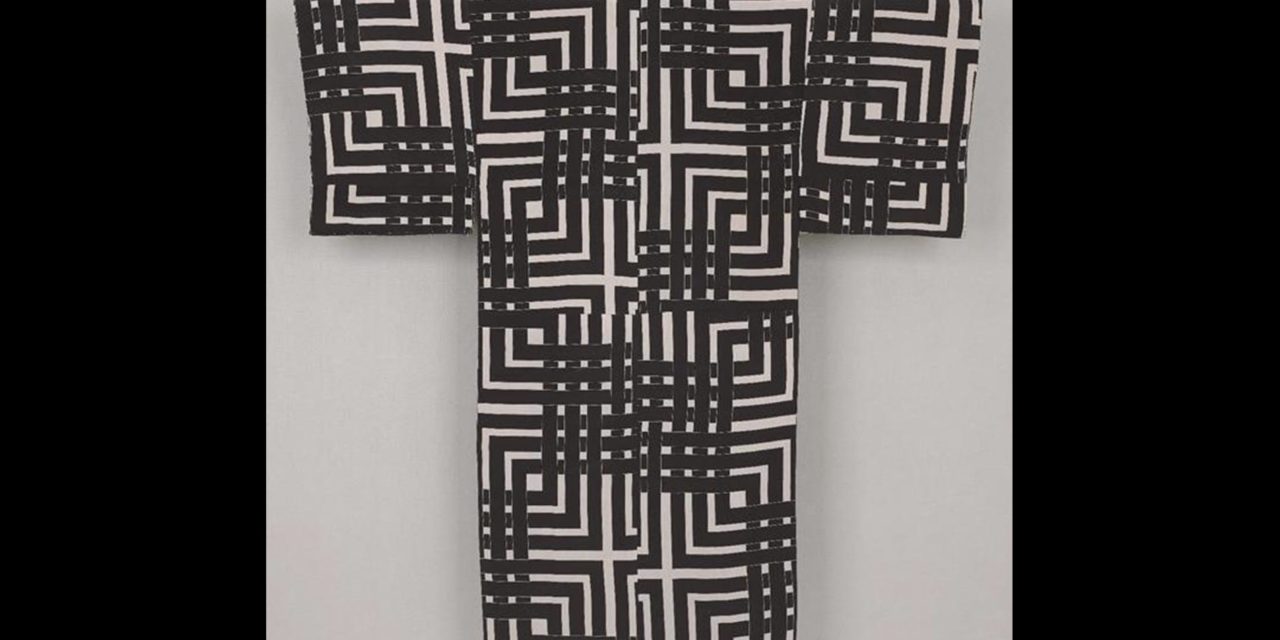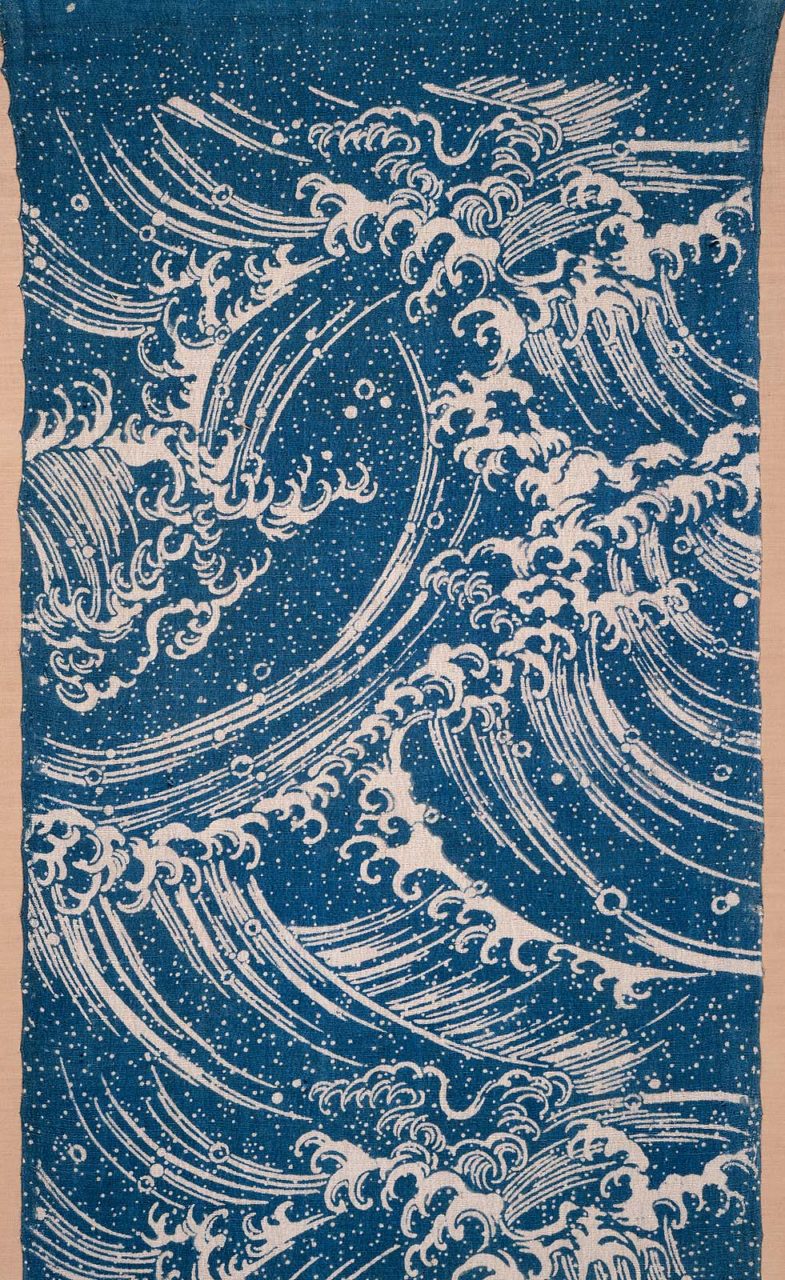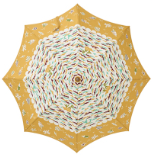A traditional Japanese method for printing designs onto fabric using a stencil and paste-resist dyes.
The Details
In the Order and Border exhibition (2010-11) at the Seattle Art Museum, there was a striking kimono on display from the 19th century (Meiji period, 1868-1912) which had been printed using the katazome technique (Fig. 1).
In their exhibit Carved Paper: The Art of the Japanese Stencil (1998), the RISD Museum explains the technique:
“Japanese paper stencils, or katagami (literally pattern paper), are the pattern-bearing tools used in a textile-dyeing process known as katazome. In this process, a dye-resistant paste is applied to cloth through a stencil made of mulberry paper which has been waterproofed with persimmon juice.”
The katagami (Fig. 2) are “often reinforced with silk threads,” RISD writes, and are a kind of art in and of themselves. They have been used since at least the 12th century in Japan for textile printing, but “the golden age of stencil dyeing came during the late Edo and Meiji periods, about 1790-1912… in response to the aesthetic needs of an increasingly affluent urban middle class” (RISD). There are many different kinds of katagami and patterns used in katazome, but all of them use paste resist.
Paste resist, as Mary Gavanas explains in The Fairchild Encyclopedia of Menswear (2008), is simply:
“a method of applying dye to woven fabric. For example: In the Japanese dyeing technique called katazome, a paste made of rice is applied to the fabric with the aid of a stencil; afterward, the dye soaks in wherever the fabric is not protected by the paste.” (275)
While the katagami is made from washi kozo (mulberry paper) and persimmon juice, traditional katazome also requires “rice flour, rice bran, calcium hydroxide (pickling lime), and indigo” dye. (Sinner)
The Museum of Fine Arts in Boston has a woman’s kimono fragment of the samurai class from the early 17th century during the Edo Period (1603-1867) (Fig. 3). This fragment is a silk damask that was stencil resist-dyed, embroidered, and also has applied gold leaf. Stencil printing was slow to progress until the Heian period (794-1185). In Japanese Costume and Textile Arts (1974), Seiroku Noma provides further insight into the development of katazome in Japanese culture, explaining that dye process were faster and cheaper than embroidery and complex weaves, so it was usually used for the lower class:
“Eventually stencil-dyeing was made easier by replacing the wooden stencils… with ones made from thick paper. Another development was the addition of resist-dyeing methods to the stencil-dyeing repertory.
Thus, instead of dyes being applied to the cloth through the cut-out parts of the stencil, dye-repellent substances like wax or rice paste were applied, so that those parts were reserved from the dye and remained the natural color of the cloth.” (154)
The MFA provides two additional examples of stencil-dyeing. In figure 4, a white wave pattern on indigo-dyed cotton fabric was achieved using katazome during the late Edo or early Meiji era in the 19th century. Beyond merely generating a repeating design, artistslike Sadao Watanabe used the method of katazome to create biblical art and representations. In Peter and the Key (1959), a stencil print was created, placed on prepared paper, and dyed with ink (Fig. 5).
Resist paste is spread across a stencil (Fig. 6) so that different layers of color can be used and each layer takes on a defined shape. The use of resist paste in Japan began in the seventh and eighth centuries, described in Beyond the Tanabata Bridge: Traditional Japanese Textiles (1993), edited by William Jay Rathbun in association with the Seattle Art Museum:
“By the eighteenth century, a repertoire of techniques for making resist patterns had developed, creating a rich legacy of graphic design […] enduring methods of decorating garments and fabrics that were worn and used by all classes of Japanese society.
The most frequently employed of these rice-paste resist techniques were the freehand tsutsugaki and the stencil-patterned katazome.” (131)
In the Kodansha Encyclopedia of Japan (1983), the authors explain that commercialization in the 18th century boosted local economies and the use of techniques like katazome:
“Cloth used in the cities was increasingly woven in the courtryside by peasant weavers who, at least by the end of the century, were often working in well organized groups. Styles were set by city merchants, especially those in Edo and Osaka. Typical of their asa and cotton garments were katazome (rice-paste-resist, stencil dyed cloth), shima (woven stripes, and kasuri (Ikat textiles).” (18)
Fig. 1 - Designer unknown (Japanese). Underkimono, 19th century (Meiji). Katazome on silk cloth; (52 x 47.25 in). Seattle: Seattle Art Museum, 2001.528. Gift of the Christensen Fund. Source: Seattle Art Museum
Fig. 2 - Designer unknown (Japanese). Katagami (hand-cut paper stencil), 19th century. Mulberry paper (kozo); persimmon stain; 25.4 x 40.6 cm (10 x 16 in). Providence: Rhode Island School of Design Museum, 05.111. Gift of Mrs. Gustav Radeke. Source: RISD
Fig. 3 - Artist unknown (Japanese). Kimono Fragment, Early 17th century Edo period. Stencil resist-dyed, embroidered, tie-dyed, and applied gold leaf on silk damask; (34 x 13.5 in). Boston: Museum of Fine Arts, 35.1941. Special Chinese and Japanese Fund. Source: Museum of Fine Arts
Fig. 4 - Artist unknown (Japanese). Textile Length, 19th century late Edo or early Meiji era. Stencil-resist dye on cotton fabric; (29 1/2 x 13 in). Boston: Museum of Fine Arts, 93.1108. Denman Waldo Ross Collection. Source: Museum of Fine Arts
Fig. 5 - Sadao Watanabe (Japanese, 1913-1996). Peter and the Key, 1959. Stencil print and ink on prepared paper; (26 5/16 x 23 3/8 in). Boston: Museum of Fine Arts, 63.1384. Gift of Sentaro Kondo. Source: Museum of Fine Arts
Fig. 6 - Maker unknown (Japanese). Katazome, 21st century. Resist paste is spread over a stencil on silk cloth. Source: Pattern and Source
Its Afterlife
K
atazome is still in use today. Textile designers Takeshi Matsunaga and Chie Takai created a collection called Kata Kata where they solely use the katazome method to create their printed designs. It is traditional for katazome prints to be dyed with indigo on cotton fabrics, but by using vibrant colors and unique prints they transform this ancient method into a highly contemporary form of surface design (Figs. 7 & 8). Their work is further described by StartUp Fashion (2012):
“Despite using such an old and traditional technique they have given it a modern twist. The dyed colors are so bright and solid they look as though they had been silkscreened or digitally printed! The adorable images cut into the stencils are much bolder and more whimsical than the usual thin, wispy florals.”
References:
- Bucci, Jessica. “Textile Trend: Katazome.” StartUp Fashion. StartUp Fashion Inc. April 11, 2012, startupfashion.com/textile-trend-katazome/.
- Gavenas, Mary Lisa. The Fairchild Encyclopedia of Menswear. Fairchild Publications 2008. Worldcat.
- Itasaka, Gen. Kodansha Encyclopedia of Japan, vol. 8. New York: Kodansha International, 1983. Worldcat.
- Noma, Seiroku. “Chapter 6: Techniques and Motifs of Japanese Textiles.” Japanese Costume and Textile Arts, vol. 16. New York: Weatherhill, 1974. Worldcat.
- Rathbun, William Jay, editor. “Katazome and Tsutsugaki.” Beyond the Tanabata Bridge: Traditional Japanese Textiles. New York: Thames and Hudson, in Association with the Seattle Art Museum, 1993. Worldcat.
- RISD. “Carved Paper: The Art of the Japanese Stencil.” RISD Museum, September 1998. Accessed January 2023. https://risdmuseum.org/exhibitions-events/exhibitions/carved-paper
- Sinner, Lauren. “Hybrid Transitions: A Modern Take on Katazome by Tyler Peterson.” Surface Design Association, Surface Design Association, 30 Oct. 2016. Read here.

















